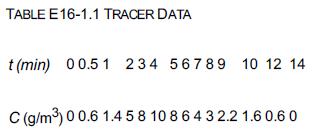Use the data in Example 16-2 to make the following determinations. a. Calculate the Pclet numbers for
Question:
Use the data in Example 16-2 to make the following determinations.
a. Calculate the Péclet numbers for both open and closed systems.
b. For an open system, determine the space time τ and then calculate the % dead volume in a reactor for which the manufacturer’s specifications give a volume of 420 dm3.
c. Using the dispersion calculate the conversion for a closed-closed vessel and tanks-in-series models, for the first-order isomerization A → B
with k = 0.18 min–1.
d. Compare your results in part (c) with the conversion calculated from the tanks-in-series model, a PFR, and a CSTR.
Example 16-2
Using the data given in Example 16-1
1. Construct the F(t) curve.
2. Calculate the mean residence time, tm.
3. Calculate the variance about the mean, σ2.
4. Calculate the fraction of fluid that spends between 3 and 6 minutes in the reactor.
5. Calculate the fraction of fluid that spends 2 minutes or less in the reactor.
6. Calculate the fraction of the material that spends 3 minutes or longer in the reactor.
Example 16-1
A sample of the tracer hytane at 320 K was injected as a pulse into a reactor, and the effluent concentration was measured as a function of time, resulting in the data
shown in Table E16-1.1.
Pulse input
The measurements represent the exact concentrations at the times listed and not average values between the various sampling tests.
1. Construct a figure showing the tracer concentration C(t) as a function of time.
2. Construct a figure showing E(t) as a function of time.
Step by Step Answer:






